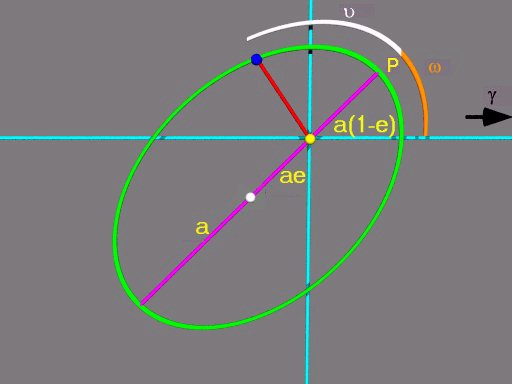 Exit Help
Exit Help
Binary Star Integrator (3D)
Help File
HELP. Displays this help screen. To exit, click one of the Exit Help buttons located at the
top and bottom of this screen.
INTEGRATION TIME. Here you specify how long into the future
the orbit should be followed. Be careful in choosing this parameter as
it is directly correlated to how long you will wait before seeing a
plot! A good strategy is to try a short integration time first to get
an idea of how fast the program is.
Orbit of the Binary Star
MASS OF STAR 1. A Solar Mass is the mass of the Sun. So a "1.0"
entered here means the star will have the same mass as our Sun, a
"2.0" means the star has twice this mass, etc.
MASS OF STAR 2. Same as above.
AVERAGE DISTANCE BETWEEN THE STARS. The average distance
between the stars is also the orbital semimajor axis. An AU is the
Earth-Sun distance.
ECCENTRICITY OF STARS' ORBITS. The eccentricty gives the shape of
the stars elliptical orbits. The eccentricity must be between 0 and
1. An eccentricity of 0.0 will produce an initially circular orbit;
larger eccentricities correspond to narrower ellipses.
Orbit of the Planet
SEMIMAJOR AXIS. Enter the semimajor axis of the planet. This is
measured with respect to the distance between the other two bodies in
orbit with each other.
ECCENTRICITY. In this space, you enter the eccentricty of the
third body's orbit. You must enter a value greater or equal to 0 but
less than 1. An eccentricity of 0.0 will produce a circular orbit.
If the eccentriciy is greater than zero the orbit will be an ellipse.
INCLINATION. The inclination is measured relative to the plane of the
orbits of the other two bodies.
ARGUMENT OF PERICENTER ( ). The argument of pericenter is the angle
measured from a reference point (
). The argument of pericenter is the angle
measured from a reference point ( ) to the pericenter (P) of the orbit with the center
chosen above as the vertex of the angle.
TRUE ANOMALY (
) to the pericenter (P) of the orbit with the center
chosen above as the vertex of the angle.
TRUE ANOMALY ( ). This
parameter specifies the angle between pericenter (P) and the
position of the planet along its orbit.
LONGITUDE OF THE ASCENDING NODE (
). This
parameter specifies the angle between pericenter (P) and the
position of the planet along its orbit.
LONGITUDE OF THE ASCENDING NODE ( ). The Longitude of the Ascending Node is an angle
measured in the reference plane from a reference point (
). The Longitude of the Ascending Node is an angle
measured in the reference plane from a reference point ( ) to the
Ascending Node. The Ascending Node is the position where the
plane of the orbit crosses the reference plane heading north.
) to the
Ascending Node. The Ascending Node is the position where the
plane of the orbit crosses the reference plane heading north.
In 2D:
 In 3D:
In 3D:

SUBMIT FORM. Send the parameters that you have chosen to the
orbital integration program!
LOAD DEFAULTS. Set all parameters back to their default values.
 Exit Help
Exit Help
 ). The argument of pericenter is the angle
measured from a reference point (
). The argument of pericenter is the angle
measured from a reference point ( ) to the pericenter (P) of the orbit with the center
chosen above as the vertex of the angle.
) to the pericenter (P) of the orbit with the center
chosen above as the vertex of the angle.
 Exit Help
Exit Help
 ). The argument of pericenter is the angle
measured from a reference point (
). The argument of pericenter is the angle
measured from a reference point ( ) to the pericenter (P) of the orbit with the center
chosen above as the vertex of the angle.
) to the pericenter (P) of the orbit with the center
chosen above as the vertex of the angle.
 ). This
parameter specifies the angle between pericenter (P) and the
position of the planet along its orbit.
). This
parameter specifies the angle between pericenter (P) and the
position of the planet along its orbit.
 ). The Longitude of the Ascending Node is an angle
measured in the reference plane from a reference point (
). The Longitude of the Ascending Node is an angle
measured in the reference plane from a reference point ( ) to the
Ascending Node. The Ascending Node is the position where the
plane of the orbit crosses the reference plane heading north.
) to the
Ascending Node. The Ascending Node is the position where the
plane of the orbit crosses the reference plane heading north.

